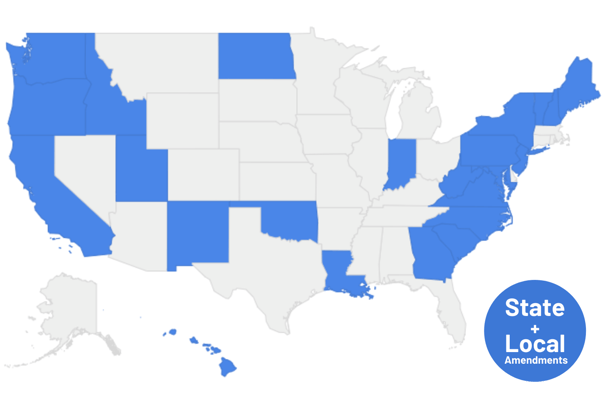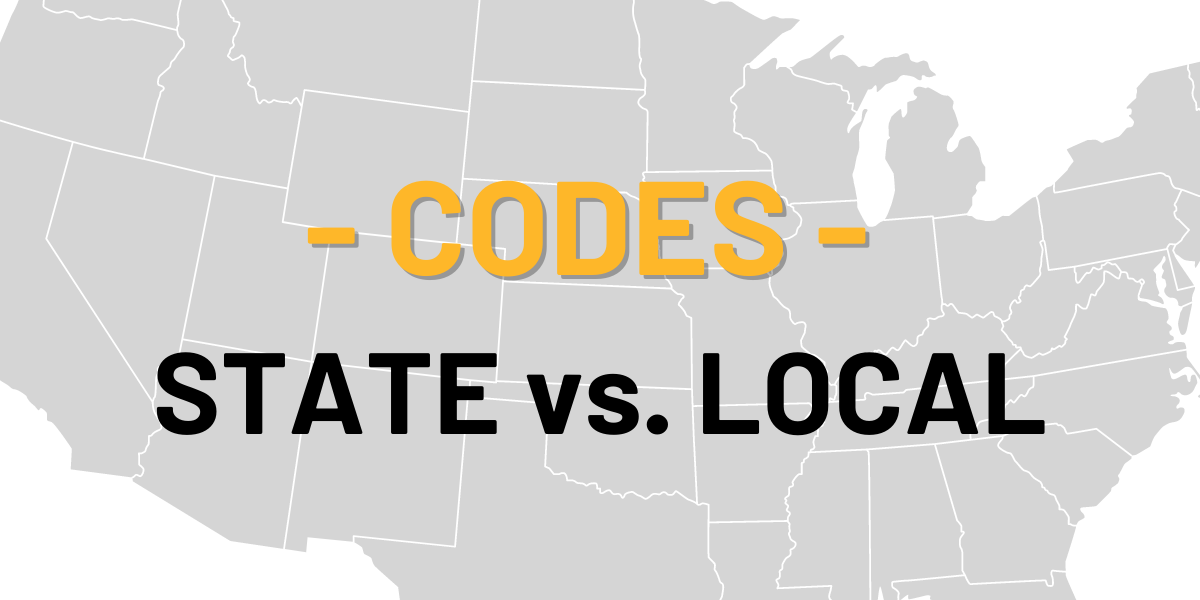In the past few years, both the construction and insurance industries have seen increased scrutiny around code adoption practices. Understanding both the latest local and state codes is critical for accurate roof insurance claims and indemnity payouts. At OneClick Code, we understand that code requirements set at the state level, amended locally, or adopted entirely by city jurisdictions can dramatically affect roofing estimates, permit fees, and project timelines. In this article, we cover how adoption mechanics differ from state to state, and what that means for contractors and adjusters reviewing claims every day.
Whether you're working in a state that strictly enforces statewide codes or one where every municipality writes its own, you’ll quickly understand that a postal address alone is not enough to be compliant. With OneClick Code’s proprietary code database, you’ll be equipped to identify the correct roofing code requirements for any address and avoid expensive mistakes on roof estimates.

State Code States
In states where building codes are adopted at a state level, there are no cities and counties that have differing codes. No matter if the project is in the hills or in the plains, if a project is in a State Code State the project will have the same building code requirements as the next house. There is not much room for argument between contractors and adjusters in these states over the topic of building codes. There are 10 states that follow the adoption of building codes at a state level with state amendments, meaning that the state decides on the codebook to adopt and does not allow for the individual cities or counties to make amendments to that code. What the state says, goes.
States that have adopted building codes and building code amendments at a state level include Connecticut, Florida, Kentucky, Massachusetts, Michigan, Minnesota, Montana, Ohio, Rhode Island, and Wisconsin.
State Codes with Local Amendments
These states follow the adoption of building codes at a state level but require local municipalities to adopt various amendments. This means that the state decides on the codebook being adopted, but local cities and counties are expected to make various amendments to the state building code that reflect each municipality's unique geographical and weather situations. This usually occurs in states where there are varying climate zones and altitudes within one state.
One example of this situation is in Utah. A home in Cache County, Utah, outside of Paradise, Utah in the north of the state is required by the county to install an ice and water shield. On the other end of the spectrum, the city of St. George, Utah does not have a history of ice damming and therefore does not require ice and water shield on the eaves of residential roofs in their area. However, both municipalities still follow the state building code adopted by the State of Utah.
States that have adopted building codes at a state level, but require local municipalities to adopt various amendments, include Arkansas, California, Georgia, Hawaii, Idaho, Indiana, Louisiana, Maine, Maryland, New Hampshire, New Jersey, New Mexico, New York, North Carolina, North Dakota, Oklahoma, Oregon, Pennsylvania, South Carolina, Utah, Vermont, Virginia, Washington, and West Virginia.

If a contractor or adjuster were to run these projects manually, meaning they would call the city or county to figure out which codes or amendments are adopted by that municipality, they would be given a “yes” or “no” related to the installation requirement of an ice and water shield. But, they would still need Table R301.2(1) to back up their information. There is now a resource for contractors and adjusters to use that provides the evidence they need to complement their estimates.
We have spoken with numerous contractors saying that they don't need services like OneClick Code because their state is a "State Code State" and then they reference the above states. This lends itself to having the wrong information on an estimate because each city and county within these states could have a different amendment than the next! States that have local amendments to state codes require more documentation than others to "prove" their accuracy. The states in this section need to be treated like - what we are calling - "local code states". See below to learn what "Local Code States" are.
Local Code States
There are 16 states that follow building code adoption at a local level, meaning it is up to each individual city and county within these states to adopt and enforce a specific building code. These states are the most challenging when it comes to gathering building codes because a house right down the street from another can require different codes which can directly impact a roofing estimate by more than 25 percent! Jurisdiction is the most important factor when it comes to creating a roofing estimate, but is often the most overlooked piece of the puzzle.
States that follow the adoption of building codes at a local level include Alabama, Alaska, Arizona, Colorado, Delaware, Illinois, Iowa, Kansas, Mississippi, Missouri, Nebraska, Nevada, South Dakota, Tennessee, Texas, and Wyoming.
.png?width=601&name=Local%20Adoption%20(1).png)
Every property in the U.S. is given a U.S. Postal Address. This address, though a good identifier of location, does not dictate jurisdiction over the property. Let's say that again, a property address does not give you the correct jurisdiction for a property. Forty percent of residences across the U.S. are located in an unincorporated part of a county, but still receive a city name in their postal address.
Proceed with caution if one claims that they "know" the code because jurisdictional boundaries are invisible and arbitrary and can change regularly within growing cities. So how does a contractor or adjuster find the jurisdiction that has authority to issue building permits over a property? Well, now they can use OneClick Code, the first-ever company to automate building code data for the roofing industry.
The Takeaway
- Most U.S. states have municipalities that have differing building codes or amendments.
- U.S. Postal Addresses are not an indicator of which municipality has jurisdiction over a property.
- Gathering building code information has historically been a manual process, but now OneClick Code can automate building codes for you.
- For the first time ever, identifying the correct jurisdiction and which building codes are adopted at a local level is a reality with the right tools.
About OneClick Data Inc.
OneClick Data Inc. is a trusted data partner dedicated to streamlining the code-sourcing process for all parties in the roofing industry while increasing efficiency and transparency for all stakeholders in construction and restoration. They have the only platform, OneClick Code, to have blazed the trail for data automation of jurisdictional authority for building codes, permit fees, taxes, and manufacturer specifications required for any address nationwide. OneClick Code has been serving customers in the contracting, insurance, and claim adjusting fields by providing instant access to trusted roofing codes with the click of a button. Offering unique reports that can be easily shared between all stakeholders in the roofing claims industry, OneClick Code adds value to all parties and empowers customers to save time and money on every claim. Welcome to restoration intelligence, automated. To learn more, visit www.oneclickcode.com.

FAQs - Frequently Asked Questions
What does it mean for a state to adopt building codes at the state level?
It means the state selects a model code (e.g., the International Building Code) and applies it uniformly across all municipalities without allowing local governments to adopt different codes or make significant amendments.
What is a “State Code with Local Amendments” model?
In this approach, the state adopts a base code, but local municipalities are permitted (or required) to pass local amendments to reflect geographic, climatic, or other regional conditions.
Why does understanding the jurisdiction matter for roofing estimates or claims?
Because the authority having jurisdiction drives the required building codes. 45% of the time, the jurisdiction does not match the postal address. If you look up required codes based on postal address and zip code, you are going to be inaccurate a lot of the time.
How can OneClick Code help you navigate complex code changes and requirements?
OneClick Code automates the identification of the correct jurisdiction, the code version adopted, and any local amendments for a given address—eliminating the ambiguity and research burden that often causes inaccurate claims and supplements.


